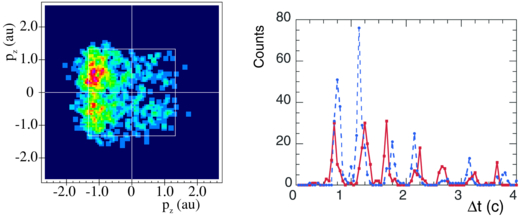 Figure showing preference for anticorrelated electrons (left) that tend to be emitted closer to the electric field zeros than their correlated counterparts
Figure showing preference for anticorrelated electrons (left) that tend to be emitted closer to the electric field zeros than their correlated counterparts
Anticorrelated Electrons From Weak Recollisions in Nonsequential Double Ionization
Abstract
The production of anticorrelated (back-to-back) electrons in double ionization of atoms by lasers at 483 or 800 nm is examined with 3D classical ensembles, for situations in which the energy available at recollision is less than the binding energy. Recollision excitation typically leads to unequal electron energies. The more energetic electron most often drifts into the backward direction, whereas the other electron may be more likely to drift into the forward direction. That electron often ionizes late in the first laser maximum after recollision or early in the second maximum.
Publication
Journal Physics B: Atomic, Molecular and Optical Physics 41 211002
Date
October, 2008
Links